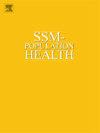儿童与邻近妇女零食摄入行为之间的关系:基于空间区域化的人群横截面分析
IF 3.6
2区 医学
Q1 PUBLIC, ENVIRONMENTAL & OCCUPATIONAL HEALTH
引用次数: 0
摘要
背景累积的证据表明,邻里环境会影响儿童的健康行为。然而,由于客观环境和感知环境的测量方法各有优缺点,因此测量邻里环境仍然具有挑战性。根据最近关于环境、感知和行为如何相互作用的概念模型,我们假设邻居的行为相似性表明物理和社会环境机会对特定行为的综合影响。然后,我们研究了这些相似性(即儿童成年邻居的行为倾向)与儿童肥胖饮食行为之间的关系。方法我们使用了日本大东京地区 2012--2013 年人口调查中 2275 名女性和 821 名小学生的数据。零食摄入量被定义为各类零食的总消费量,使用有效的自填式饮食史问卷进行估算。空间区域化是一种空间聚类方法,用于根据经验确定能够有效区分女性零食摄入行为区域差异的细分区域。我们进行了多元回归分析,以评估儿童零食摄入量与邻近妇女平均零食摄入量之间的横截面关联,并对母亲的摄入量进行了调整。讨论结果表明,除了母亲的影响外,家庭外的物质环境和社会邻里环境还能提供行为机会,从而与儿童的饮食行为产生不可忽视的联系。本文章由计算机程序翻译,如有差异,请以英文原文为准。
Association between snack intake behaviors of children and neighboring women: A population-based cross-sectional analysis with spatial regionalization
Background
Accumulated evidence indicates that neighborhood environments affect children's health behaviors. However, measuring neighborhood environments remains challenging because there exist strengths and weaknesses both in objective and perceived environment measures. Drawing on a recent conceptual model of how environment, perception, and behavior interact, we hypothesized that neighbors' behavioral similarities indicate the combined influence of physical and social environmental opportunities on specific behaviors. We then examined how these similarities (i.e. the behavioral tendencies of children's adult neighbors) relate to children's obesogenic dietary behaviors.
Methods
We used data for 2275 women and 821 elementary schoolchildren from a 2012–2013 population-based survey in greater Tokyo, Japan. Snack intake was defined as the total consumption of various types of snacks, estimated using a validated self-administered diet history questionnaire. Spatial regionalization, a type of spatial clustering, was used to empirically identify segments that could effectively differentiate regional variation in women's snack intake behaviors. We conducted multiple regression analysis to assess the cross-sectional association between children's snack intake and the mean snack intake of neighborhood women, adjusting for mother's intake.
Results
A 1-g increase in the mean snack intake of neighborhood women was associated with a 0.23-g (95% confidence interval: 0.00–0.45) increase in children's intake, while a 1-g increase in mother's intake was associated with a 0.34-g (95% confidence interval: 0.26–0.41) increase in children's intake.
Discussion
The results suggest that the out-of-home physical and social neighborhood environments may have non-ignorable associations with children's dietary behaviors by offering behavioral opportunities in addition to maternal influence.
求助全文
通过发布文献求助,成功后即可免费获取论文全文。
去求助
来源期刊

Ssm-Population Health
PUBLIC, ENVIRONMENTAL & OCCUPATIONAL HEALTH-
CiteScore
6.50
自引率
2.10%
发文量
298
审稿时长
101 days
期刊介绍:
SSM - Population Health. The new online only, open access, peer reviewed journal in all areas relating Social Science research to population health. SSM - Population Health shares the same Editors-in Chief and general approach to manuscripts as its sister journal, Social Science & Medicine. The journal takes a broad approach to the field especially welcoming interdisciplinary papers from across the Social Sciences and allied areas. SSM - Population Health offers an alternative outlet for work which might not be considered, or is classed as ''out of scope'' elsewhere, and prioritizes fast peer review and publication to the benefit of authors and readers. The journal welcomes all types of paper from traditional primary research articles, replication studies, short communications, methodological studies, instrument validation, opinion pieces, literature reviews, etc. SSM - Population Health also offers the opportunity to publish special issues or sections to reflect current interest and research in topical or developing areas. The journal fully supports authors wanting to present their research in an innovative fashion though the use of multimedia formats.
 求助内容:
求助内容: 应助结果提醒方式:
应助结果提醒方式:


